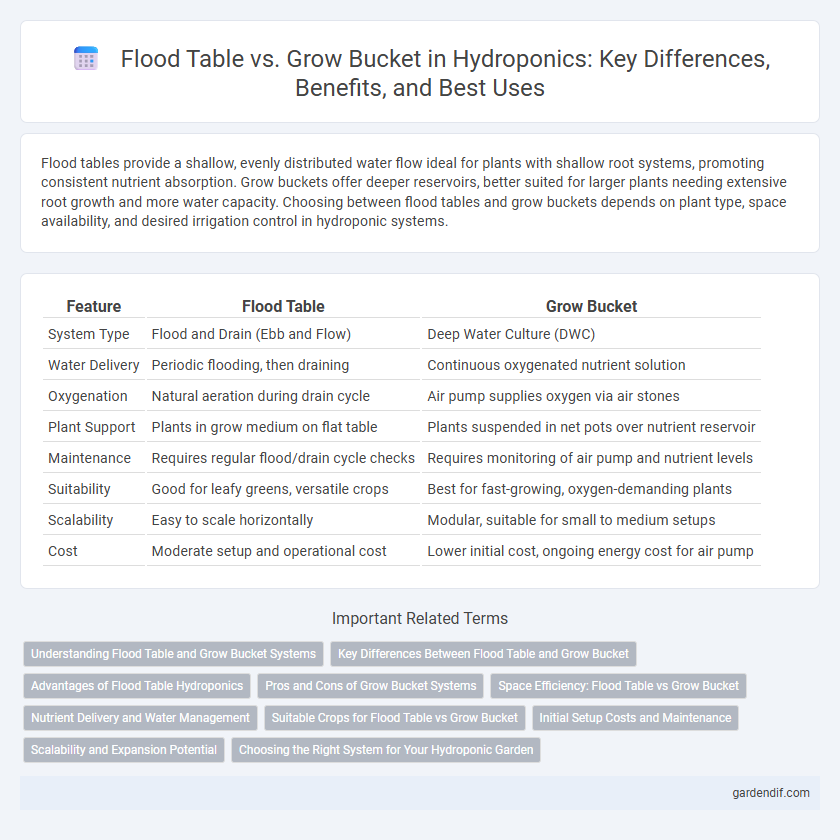
Flood Table vs Grow Bucket Illustration
Flood tables provide a shallow, evenly distributed water flow ideal for plants with shallow root systems, promoting consistent nutrient absorption. Grow buckets offer deeper reservoirs, better suited for larger plants needing extensive root growth and more water capacity. Choosing between flood tables and grow buckets depends on plant type, space availability, and desired irrigation control in hydroponic systems.
Table of Comparison
| Feature | Flood Table | Grow Bucket |
|---|---|---|
| System Type | Flood and Drain (Ebb and Flow) | Deep Water Culture (DWC) |
| Water Delivery | Periodic flooding, then draining | Continuous oxygenated nutrient solution |
| Oxygenation | Natural aeration during drain cycle | Air pump supplies oxygen via air stones |
| Plant Support | Plants in grow medium on flat table | Plants suspended in net pots over nutrient reservoir |
| Maintenance | Requires regular flood/drain cycle checks | Requires monitoring of air pump and nutrient levels |
| Suitability | Good for leafy greens, versatile crops | Best for fast-growing, oxygen-demanding plants |
| Scalability | Easy to scale horizontally | Modular, suitable for small to medium setups |
| Cost | Moderate setup and operational cost | Lower initial cost, ongoing energy cost for air pump |
Understanding Flood Table and Grow Bucket Systems
Flood table systems use a shallow tray periodically flooded with nutrient-rich water, promoting oxygenation and efficient root hydration, ideal for leafy greens and herbs. Grow buckets employ individual containers filled with a growing medium, allowing targeted watering and nutrient delivery, suitable for larger plants like tomatoes and peppers. Both systems optimize water and nutrient use but differ in scalability and plant type compatibility.
Key Differences Between Flood Table and Grow Bucket
Flood tables utilize a shallow, water-flooded surface to deliver nutrient solutions directly to plant roots, promoting uniform moisture and aeration, while grow buckets, typically container-based, rely on reservoir water levels and wicking systems for nutrient delivery. Flood tables support better root oxygenation and are ideal for leafy greens and delicate plants, whereas grow buckets offer versatility for larger crops and easier mobility. The choice between flood tables and grow buckets often hinges on crop type, space availability, and system maintenance preferences.
Advantages of Flood Table Hydroponics
Flood table hydroponics offers superior oxygenation and nutrient distribution by periodically flooding the root zone, promoting faster plant growth compared to grow buckets. Its large surface area allows for higher plant density and easier maintenance, reducing labor and irrigation complexity. Additionally, flood tables provide enhanced root aeration and efficient nutrient recycling, improving overall crop yield and quality.
Pros and Cons of Grow Bucket Systems
Grow bucket systems in hydroponics offer precise nutrient control and reduced water usage, making them ideal for consistent plant growth. These systems provide excellent root aeration and are space-efficient, but they require regular monitoring to prevent nutrient imbalances and potential clogging. Maintenance complexity and initial setup costs can be higher compared to flood table systems, limiting their ease of use for beginners.
Space Efficiency: Flood Table vs Grow Bucket
Flood tables offer superior space efficiency due to their large surface area, allowing multiple plants to grow simultaneously in a compact arrangement ideal for commercial hydroponic farms. Grow buckets, while easier to manage for smaller setups, often require more space per plant because each bucket occupies individual room and limits close plant spacing. The flood table system maximizes vertical and horizontal space usage, optimizing yield per square foot compared to grow buckets.
Nutrient Delivery and Water Management
Flood tables provide uniform nutrient delivery by periodically flooding the plant roots and allowing excess solution to drain, optimizing oxygen availability and preventing root rot. Grow buckets use individual reservoirs for each plant, enabling precise water management and tailored nutrient concentrations but require more monitoring to avoid stagnation. Both systems offer efficient water use, with flood tables favoring larger-scale setups and grow buckets suited for customizable, smaller-scale hydroponics.
Suitable Crops for Flood Table vs Grow Bucket
Flood tables are ideal for leafy greens like lettuce, spinach, and herbs due to their shallow root systems and frequent nutrient exposure. Grow buckets suit fruiting crops such as tomatoes, peppers, and cucumbers, offering deeper root zones and steady water drainage. Both systems optimize nutrient delivery but cater to different crop categories based on root depth and growth requirements.
Initial Setup Costs and Maintenance
Flood tables generally require a higher initial investment due to their larger infrastructure and automated water delivery systems, while grow buckets are more cost-effective for small-scale or hobbyist setups. Maintenance for flood tables involves regular cleaning of the tray and pump systems to prevent clogging and algae growth, whereas grow buckets demand frequent monitoring of nutrient levels and water quality in each individual container. Both systems require routine upkeep, but flood tables may incur higher maintenance expenses due to complex plumbing parts.
Scalability and Expansion Potential
Flood tables offer greater scalability for hydroponic systems by allowing easy expansion through modular sections, supporting larger crop volumes and diverse plant varieties efficiently. Grow buckets are limited in scaling due to fixed container sizes and individual irrigation setups, making expansion more labor-intensive and space-consuming. For commercial operations targeting rapid growth and increased yield, flood tables provide superior scalability and streamlined system expansion potential.
Choosing the Right System for Your Hydroponic Garden
Flood table systems provide even water distribution and are ideal for large-scale hydroponic gardens requiring consistent nutrient delivery and root aeration. Grow buckets offer a compact, space-efficient solution suitable for small to medium setups, allowing precise control over individual plant watering and nutrient management. Selecting the right system depends on garden size, crop type, and the level of automation desired for optimal growth and yield.
Flood Table vs Grow Bucket Infographic

 gardendif.com
gardendif.com